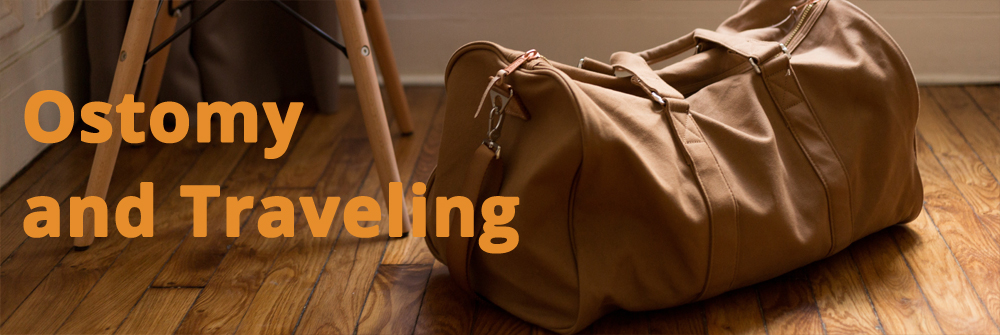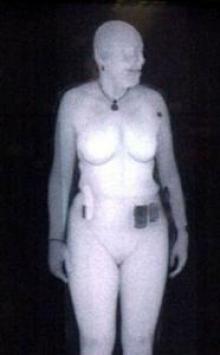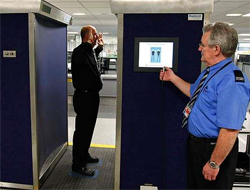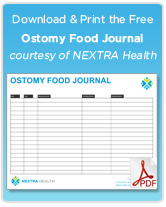Interesting goings-on about Ostomy on the Web:
1) President of the UOAA wrote an article titled “Forging the Clinician-Patient-UOAA Partnership”
2) L.A. Times wrote a piece on traveling with an ostomy.
3) You can donate unused Ostomy supplies to the people in Haiti through Friends of Ostomates Worldwide
4) A boyfriend’s take on Ostomy
5) “Intestines are Overrated” T-shirt
A paralyzed man with an ostomy is suing an Ohio hotel he previously stayed at for denying him a room under the Americans with Disabilities Act.
In December, Shawn Pouliot tried to book a room at the Akron City Centre Hotel and was told he was banned for life. On a previous visit in August 2009, Shawn’s ostomy bag leaked out while he was in bed and made a big mess. Shawn threw the dirty linens in a bag and gave the hotel over $500 to cover the costs of any damage.
Tuesday Shawn filed a law suit in Federal Court against the hotel for denying him a room.
Ok, so this isn’t directly about Ostomy, but it’s noteworthy news. Convatec, a provider of Ostomy supplies as well as wound and skin care supplies used by many has provided relief efforts and aid from its Dominican-based manufacturing plant by sending $400,000 in wound care bandages and dressings to Haitians needing medical supplies fast.
Convatec is cooperating with the Red Cross to get these supplies to the Haitians who need them most and to get them as fast as possible. It is good to see a generous donation from a corporation with the means and supplies to help in what could possibly be the largest humanitarian crisis of 2010.
Thanks to Convatec, organizations, governments, and individuals donating and/or helping in Haiti. Please continue to support these relief efforts. Time is of the essence for these impoverished people whose lives are depend on the generosity and aid of the rest of the world.
**See our Updated 2012 Ostomy Reading List**
 There’s a lot of great material out there about ostomy and the diseases that can require one to get ostomy surgery. Books offer a unique opportunity to hear the voice of the individual, giving you a fresh perspective and fresh ideas. Make it a resolution this year to fit more books in your life.
There’s a lot of great material out there about ostomy and the diseases that can require one to get ostomy surgery. Books offer a unique opportunity to hear the voice of the individual, giving you a fresh perspective and fresh ideas. Make it a resolution this year to fit more books in your life.
Here is a list of top rated reading material about Ostomy that you can find on Amazon.com:
Rated 5 stars on Amazon, this book is essentially the Ostomy Bible. Written by an Ostomy patient, it discusses the practical aspects of an ostomy and current medical technology with a personal, individualized touch, extending its message into the emotional and mentally challenges faced by those with an ostomy. It also gives guidelines and facts to safely enjoy athletics, sex, and pregnancy with an Ostomy. Fantastic reading and highly recommended for anyone who either has an ostomy or has a spouse or child with an ostomy.
Witty, humorous & sometimes sarcastic, this book features the honest stories from many healthcare workers and ostomy patients about their experiences with ostomy. Sort of a “Chicken Soup” book for Ostomy, it’s filled with inspiring stories of others who are faced with the challenges of ostomy every day, offering encouragement and inspiration to those who can relate – and not to mention a few laughs as well.
By Barbara Barrie – Barbara tells her own personal story of recovery and life with an ostomy.
Ok, so this one is not a book, but it’s a useful laminated reference chart for those who need it.
This one is especially useful for nursing students or nurses who have patients with incontinence or an ostomy. Question-and-answer format guide to ostomy, wound, and continence care for nurses. Logical, easy to read guide with over 400 helpful pages of information pertaining to nursing for ostomy patients.
IBD, Crohn’s, and Ulcerative Colitis Books
Here are some top rated readings specific to IBD, Crohn’s, and UC:
A guidebook for those who have been recently diagnosed with Crohn’s or Ulcerative Colitis and the lifestyle changes needed to face the new challenges presented.
Written by a patient, for a patient – Authro Tracie Dalessandro has ulcerative colitis and Crohn’s disease. She’s also a dietitian and nutritionist with a Master of Science in Nutrition from New York Medical College. Tracie focuses on diets specifically for those with IBD to help reduce symptoms and feel better. This book includes her personal experiences as well as practical advice including over 50 recipes, menu planning guides, a “dining out” guide, and how to correct vitamin and mineral deficiencies.
This book is rather dry, but a useful guide to help those challenged with Crohn’s or Ulcerative Colitis. Recommended especially for new patients who have questions they haven’t asked, or even questions they haven’t thought of.
Many of us who have to visit the doctor frequently always wonder if we’re seeing the whole picture or not. If you’re one of them, this book is a good read for you. This book by David Dahlman explains the importance of diet in dealing with the symptoms of IBS, Crohn’s, and Colitis. The author believes that your symptoms are caused by 9 variables and changing your diet can address these variables.
Ostomies, especially for children, give the impression that they will prevent them from participating in activities. However, this isn’t necessarily true. While it’s an inconvenience not experienced by other children, those with an ostomy can still do all the same things – play sports, go swimming, ride bikes, etc.
Ostomies are particularly difficult with children than adults for a few reasons. The first reason is that an ostomy can make them feel “different” from the other children. This can develop resentment, shyness, and embarrassment. There are many situations that children face – for instance, changing in locker rooms – that can make a child fearful or embarrassed.
Here are a few tips for helping your child with Ostomy:
- The best thing you can do is respond positively and informatively about ostomy. Children respond to your reactions. Explain ostomy to them clearly or have a doctor do it. Answer their questions, and do your best to keep an open dialogue about the ostomy.
- If your child is uncomfortable speaking about it, respect their privacy and ensure they’re properly managing their ostomy if they’re at an age to do so on their own.
- Speak with your child’s school teachers, counselors and principals. Let them know the situation up front so the teachers to help facilitate their comfort around other students.
- Emptying or changing an Ostomy appliance can be stressful for a child who is at school or among their peers. When present, help them find a comfortable place to do so. If they’re at school, also ensure the staff understand and can assist with finding a private place – for instance, in the nurse’s office or discreetly in a bathroom.
A final note on children is that having an ostomy requires responsibility on their part to take care of their stoma and maintaining their ostomy appliances. Nothing is more difficult for a child managing their ostomy than not having the right tools available to them when they need it. Help your child by ensuring they always have the right tools, pastes, pouches, and barriers at all times in case they are in need of an appliance change or cleaning. Assist them with any preparations needed for their appliances, like cutting the wafer. Also be sure they have a good understanding of all of the tools, pastes, and powders needed and how to use them properly.
4RVCC8Q7AT98
For new ostomates, the first step of taking care of your ostomy is to first understand all of the ostomy supplies, how to use them correctly, and how they work. You should do this first because you’ll be changing your own appliances, but you’ll also be able to communicate more effectively with healthcare professionals and retailers providing your ostomy supplies.
Brand Names: You’ll find many leading manufacturers of Ostomy products, and you may get recommendations for different reasons. Three of the biggest providers of ostomy supplies are Hollister, Convatec, and Coloplast. There are online medical suppliers who can supply discount ostomy supplies.
Here’s a list of supplies and a brief description of them:
- Skin Wafers – A Skin Wafer, or “flange”, fits around the stoma. Since stomas can come in all shapes and sizes, the wafer typically requires cutting unless the manufacturer will pre-cut them for you. There are moldable wafers on the market, but most will require cutting to fit the patient’s stoma.
- Ostomy Pouches – There is a lot of variety in ostomy pouches – they come in all shapes, sizes, and types.
- “One Piece” vs. “Two Piece” – The “one piece” system means the pouch is directly attached to the skin wafer. The “two piece” system means the pouch can be detached from the wafer and replaced, emptied, and/or cleaned.
- “Closed End” vs. “Open End” – An “open-ended” pouch is drainable and reusable. The bottom is closed off with Velcro or a clip. A “closed-end” pouch has no opening, so it’s not reusable but is preferable for outdoor activities and swimming where leaking could occur.
- Sizes of Pouches – Pouches can come in a number of sizes, including small pouches designed to be more discreet (but will have to be changed more frequently).
- Adhesive Remover – An adhesive remover wipe is used to treat the skin where the wafer attaches around the stoma. It helps keep the skin clean and non-irritated.
- Skin Barrier Wipes – Skin barrier wipes are applied before putting a new stoma onto the skin. They help keep the skin around the stoma infection-free and wound-free from the adhesives needed on the wafer. It will help ensure the adhesive on the wafer will stick.
- Stoma Powder – Stoma powder helps dry up moisture so the wafer sticks well and promotes healing for irritated skin.
- Stoma Pastes – Helps the wafer stick well and evens out the skin surface so the wafer adheres confidently.
- Barrier Rings – Like the stoma pastes, it helps even out skin surface and keep the wafer in place.
- Ostomy Belt – The belt will help the wafer in place against the body by putting pressure on the edges.
- Miscellaneous Supplies – To ensure cleanliness and proper use of your ostomy supplies, you’ll also need a few more things:
- Pen – To make your markings on your wafer to make the cut
- Scissors – To cut the wafer to the size of the Stoma
- Soap – Cleanliness is next to godliness. Or at least keeps infections away.
- Several washcloths – You’ll want clean cloths to wipe any leakage or waste as well as to dry off the skin or appliances before applying them.
- Mirror – This can be useful if you need to get a good view of your stoma while handing your wafer our pouch.
This is a brief overview of what you should keep handy in your “ostomy kit”. If you’re active, working, swimming, in school, or travelling, you should always pack a separate kit to take with you. The best way to ensure you’re always with your tools is to bring two extra sets of supplies (wafers, pouches, pastes, etc.) with you at all times. This way, if you have to use one, you’ve got another accessible to you in case of emergencies.

When they first get ostomy surgery, most folks are immediately concerned about how their lives will change. But with some planning, most come to find that their lives don’t change as much as they first believed.
While the time you’re using an ostomy pouch, and the time the pouches are drained can be managed, preparation for accidents can save a lot of embarrassment. Here are some tips to make all the preparations:
1) Pack a “travel kit” – Make a separate kit to take with you that includes two brand new ostomy appliances. Also throw a couple sanitary bags in there as well. All of this can be carried in a small discreet bag or tote, always available in case you need it.
2) Keep supplies nearby where you spend a lot of time – Just like your travel kit, have a separate supply available to you in case you need it at work, school, or anywhere you’re spending hours at a time.
3) Keep an extra pair of clothes – you never know when you may need them.
4) Keep a Contact – Make sure a family member or friend knows where you’re supplies are at, they know what they are, and how to get them to you.
5) Have a supplier handy – If you’re out of town, it’s a good idea to find out the locations of medical supply stores in advance. If you have no other options, have a supplier online who can get you ostomy supplies next day if you have no other options.
Want more? See this fantastic Travel article by the United Ostomy Association of America:
Ostomy Travel Tips from the UOAA
***UPDATE 11/24/2010***
The TSA has recently implemented new procedures for backscatter x-rays (like the image seen below) and “enhanced pat downs” for passengers boarding aircraft. These new procedures have caused just a bit of a tissy in the general public, and definitely so regarding Ostomy.
This method is far more intrusive than how security was previously done, especially those who are disabled and/or have a medical appliance. The UOAA has put together a fantastic update this month specific to air travel.
I recommend all Ostomates concerned with security and flying read it here.
If you would like, continue reading below; the below was written a year ago and is now more relevant than ever.
 Since last weeks mishaps and security failures when a possible terrorist attempt occurred on a U.S. inbound flight to Detroit was discovered, the immediate reaction from our leadership is to create more security. But there is a balance – and the balance is with privacy and liberty. More security always means less liberty. Less liberty in this case mainly applies to less privacy, namely your own body.
Since last weeks mishaps and security failures when a possible terrorist attempt occurred on a U.S. inbound flight to Detroit was discovered, the immediate reaction from our leadership is to create more security. But there is a balance – and the balance is with privacy and liberty. More security always means less liberty. Less liberty in this case mainly applies to less privacy, namely your own body.
The newest technology to increase security is the development of full body scanning, which allows TSA to visibly see a detailed image of your naked body under your clothing as well as anything you may have attached to your person. This would allow TSA to see anything attached to the outside of the body to TSA onlookers. This would help them spot explosives or devices that a terrorist could use to blow up an airplane.
But what about those with an ostomy? In addition to guns and bombs, full body scanners will openly display anything outside of your body to TSA security onlookers, including ostomy bags, catheters, urine leg bags, and other private medical devices.
While security and safety are concerns of flying, for many of us with health conditions it is an affront to our privacy, especially those with a medical device that we would rather not share with airport security. What if it’s mistaken for a bomb? This is not only an embarrassing mistake for TSA, it can be potentially very embarrassing for the traveler to have to reveal their medical condition to strangers. This type of experience at a public airport – being pulled aside, interrogated, and stripped to reveal your medical devices – makes the prospect of flying very unpleasant for millions of people.
There are, however, many in power that feel that this new security is an important measure to airline safety. Douglas Laird, former Security Director for Northwest Airlines shrugs off privacy concerns as he did in this interview:
I believe we have to give up some rights for the safety of everybody. It’s a real nerve that you touch when you mention that.
A real nerve indeed – in the past decade we’ve given up many rights in the name of safety. And I think it’s safe to guess he doesn’t have an ostomy bag.
Ok… so I have an Ostomy and I’m flying… what should I do?

In many ways, the problems of ostomy and airports is not a new one. Many people with ostomies have already been searched, patted down, or even investigated by TSA security staff in an airport before getting on the plane. Ostomates have also had trouble bringing certain supplies like scissors in their ostomy kits onboard.
So, while this full body scanning technology is invasive for many who believe in privacy, in general for flying this will probably change little other than compromising your privacy. For many both with and without ostomy it’s an important concern. However, if you do happen to be flying, it is very likely TSA staff understands and expects to find individuals with an ostomy device attached. The best thing you can do for yourself and other ostomates in a scenario where you are confronted is cooperate & explain that you’re wearing an ostomy device.
Some tips for ostomy and airport screenings:
- 1) Make sure your pouch is emptied before getting onto a flight.
- 2) You have the right to be searched in private and by someone of the same sex.
- 3) Let TSA know that you’re carrying medical supplies and – if asked – cooperate and tell them you’re wearing a medical device.
- 4) Send complaints to TSA if you feel your privacy or rights have been violated in any way, or if you have suggestions to make the process easier.
UOAA.org discussion about Ostomy and airport screenings
The internet is a budding social platform, loaded with networks of people meeting through similar interests. Now, those with ostomies can now meet an osto-mate through MeetAnOstoMate.com, a social network for those with ostomies in mind.
The Website helps you find others in your area with ostomies and even create your own profile so others can connect with you.
Meetanostomate.com also launched a global campaign to raise awareness about ostomy and provide a place where those with ostomies can socialize, provide tips, resources, and support.
There are currently over 2,800 members and growing. Check it out today.













